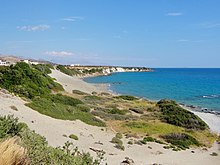Frangokastello
Frangokastello ( Greek Φραγκοκάστελλο ( n. Sg. )) Is a scattered settlement on the south coast of the Mediterranean island of Crete ( Greece ) with about 150 inhabitants. It belongs to the municipality of Sfakia in the regional district of Chania and is located about 10 kilometers east of the main town of Chora Sfakion . The settlement is named after the Venetian fort of the same name .
description
Frangokastello lies on the southern edge of a sparsely vegetated plain against the backdrop of the Kryoneritis Mountains . The settlement, named after a Venetian fortress, does not form a closed settlement area because it is repeatedly loosened up by open spaces. Despite a few hotel complexes and taverns, there are no high-rise buildings, which reinforces the spacious impression of the settlement.
The beach of Frangokastello is located below the fortress on a peninsula. The lagoon to the west forms a natural harbor basin for the fishing boats lying there. The beach of fine, light sand slopes gently into the sea. It is very popular during the season. In front of the fort on the beach there is a tavern with souvenir sales. Loungers and parasols are also available for hire.
About 500 meters to the east is the less visited beach of Orthi Ammos (Ορθή Άμμος, "steep sand"). Strong winds, which are particularly common in autumn, have formed high sand dunes on the steep coast. The beach can be reached via a staircase between the dunes, which begins at the entrance of a hotel complex on the opposite side of the unpaved coastal path.
The shore at Orthi Ammos drops into the sea faster than at the fortress. The sand of the beach is a little darker and there are some rock slabs in the shallow water. On the beach of Orthi Ammos is nudist usual, though not exclusively.
history
The name Frangokastello comes from a Venetian fort built in 1371 in front of a flat peninsula , of which the crenellated outer walls still stand today. The coat of arms of the Venetian builders, the lion of St. Mark, is emblazoned above the south portal of the fortress . Inside the building, however, only the foundation walls of the facility are visible. The castle, which was restored by the Venetians under their commander Nicolo Dona in 1593, was later abandoned. The Sakiot natives subsequently removed the beams from the towers and rooms.
Originally the fort was named after Saint Nikitas, just as the Agios Nikitas church, 350 meters east of the fortress, is dedicated to this saint. However, the name "Frankenkastell" soon became common among the local Greeks, after the common name used by Western Europeans, including the Venetians, in the Middle Ages in the eastern Mediterranean, as "Franks" (frangi) . The church of Agios Nikitas is built in place of an early Christian basilica, from which remains of a mosaic floor are still preserved, which are in front of the church.
In 1770 the leader of the Cretan insurgents Ioannis Vlachos (Ιωάννης Βλάχος), known as Daskalogiannis (Δασκαλογιάννης), was arrested by Ottoman soldiers in Frangokastello . He was executed the following year on June 17, 1771 in Kandiye, now Heraklion .
In May 1828, Frangokastello was the scene of a battle between rebellious Greeks under their leader Chatzimichalis Dalianis and Ottoman soldiers. The Dalianis from Epirus tried to transfer the Greek struggle for independence from the mainland to Crete. The rebels, 600 infantrymen and 100 cavalrymen , coming from Gramvousa , occupied the fort at the beginning of March 1828, but were defeated by the Ottomans in the battle of May 18, 1828. Dalianis and 385 other Greeks were killed. Of the 8,000 infantrymen and 300 cavalrymen of the Ottomans under Moustafa Pascha, the governor of Crete, who attacked Frangokastello from the Asfikou plateau, around 800 soldiers died. During the retreat to Chania by May 30th, the Ottomans lost another 1,000 men to ambushes by the Sfakiots.
According to local tradition, around the anniversary of the battle, at dawn, the shadows of the Cretans killed in the fort return to the place of the event. They are called drosoulites ("dew shadow") and can possibly be explained as a special meteorological phenomenon that occurs in the Frangokastello plain in late spring, from late May to early June.
- Views of the fort
Individual evidence
- ↑ Results of the 2011 census at the National Statistical Service of Greece (ΕΣΥΕ) ( Memento from June 27, 2015 in the Internet Archive ) (Excel document, 2.6 MB)
- ↑ Alberta Galla, Michele Buonsanti: The Most Beautiful Beaches of Crete - A Guide to the Hidden Picturesque Spots along the Cretan Coast. Mystis Editions, Iraklio 2006, p. 69, ISBN 960-6655-13-X .
- ↑ Theocharis E. Detorakis: History of Crete . Th. Detorakis, Iraklio 1997, ISBN 960-90199-4-3 , The Revolution of 1821–1830, pp. 330/331 .
Web links
- Frangokastello in south-west Crete. Explore Crete, accessed October 11, 2016 .
- Description of the "Drosoulites" phenomenon
Coordinates: 35 ° 10 ′ 56 ″ N , 24 ° 14 ′ 2 ″ E







